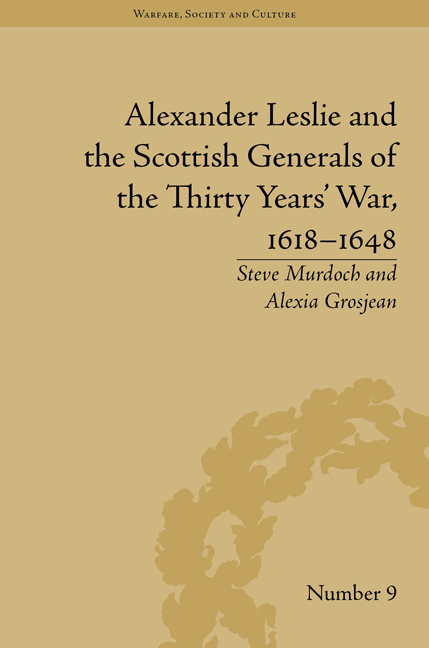Book contents
- Frontmatter
- CONTENTS
- Dedication
- Acknowledgements
- Abbreviations
- Stylistic Conventions
- Introduction
- 1 Scotland's Indigenous Military Cultures
- 2 The Scottish Military Diaspora
- 3 The Thirty Years' War Campaigns: Stralsund to Prague, 1628–35
- 4 Alexander Leslie and the Army of the Weser, 1635–9
- 5 The Home Front: Leslie, Ruthven and the Bishops' Wars, 1638–41
- 6 The Scottish ‘Veteran Generals’ in England, 1642–7
- 7 Going Full Circle: The New Scottish Command in Europe, 1639–48
- Conclusion
- Appendix
- Notes
- Works Cited
- Index
5 - The Home Front: Leslie, Ruthven and the Bishops' Wars, 1638–41
- Frontmatter
- CONTENTS
- Dedication
- Acknowledgements
- Abbreviations
- Stylistic Conventions
- Introduction
- 1 Scotland's Indigenous Military Cultures
- 2 The Scottish Military Diaspora
- 3 The Thirty Years' War Campaigns: Stralsund to Prague, 1628–35
- 4 Alexander Leslie and the Army of the Weser, 1635–9
- 5 The Home Front: Leslie, Ruthven and the Bishops' Wars, 1638–41
- 6 The Scottish ‘Veteran Generals’ in England, 1642–7
- 7 Going Full Circle: The New Scottish Command in Europe, 1639–48
- Conclusion
- Appendix
- Notes
- Works Cited
- Index
Summary
Att endoch hans tjenst vore oss kär och vij icke ville then mista, lijkväll mädhan han så insisterar ther på, bevekt aff sitt fädernesslandz trouble stat, kunne vij honom … sådan dimission intett förvägra och honom förhindra tjäna sitt fädernesslandh
From the earliest weeks of 1638 few people could doubt that Charles I faced the prospect of a rebellion in his ‘native kingdom’. Ostensibly Scottish agitation was triggered by the threat of religious uniformity being imposed by the king, thereby disregarding the Calvinist traditions of the Kirk in Scotland and resulting in the drafting and signing of the National Covenant in 1638. It is generally agreed that religious and political tensions in Scotland can be easily traced to the 1633 Scottish Coronation Parliament and even to the proroguing English Parliament in 1629. The Covenanting movement represented a revolutionary alliance comprising the majority of the nobility (especially the lairds), the commercial classes and the Presbyterian interest in Scotland. These combined to redress constitutional and nationalist grievances in the state as well as to uphold the Presbyterian version of the reformed tradition in the Kirk. Scrutiny of the political and religious discord will here only be touched on briefly where it informed the decisions of the Scottish military commanders who fought either for or against the Covenanter regime.
- Type
- Chapter
- Information
- Publisher: Pickering & ChattoFirst published in: 2014

